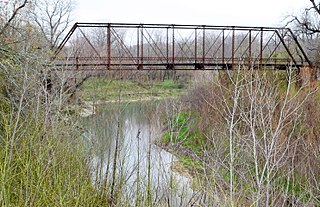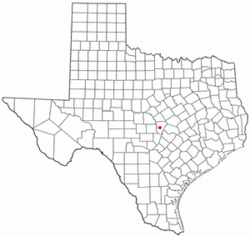
Lampasas County is a county located on the Edwards Plateau in the U.S. state of Texas. As of the 2020 census, its population was 21,627. Its county seat is Lampasas. The county is named for the Lampasas River.

Burnet County is a county located on the Edwards Plateau in the U.S. state of Texas. As of the 2020 census, the population was 49,130. Its county seat is Burnet. The county was founded in 1852 and later organized in 1854. It is named for David Gouverneur Burnet, the first (provisional) president of the Republic of Texas. The name of the county is pronounced with the emphasis or accent on the first syllable, just as is the case with its namesake.

Burnet is a city in and the county seat of Burnet County, Texas, United States. The population was 6,436 at the 2020 census.

Copperas Cove is a city located in central Texas at the southern corner of Coryell County with smaller portions in Lampasas and Bell counties. Founded in 1879 as a small ranching and farming community, today the city is the largest in Coryell County, with 32,032 residents as of the 2010 census and an estimated 33,235 residents in 2019. The city's economy is closely linked to nearby Fort Hood, making it part of the Killeen-Temple-Fort Hood Metropolitan Statistical Area. Local people usually refer to the town as just "Cove".
Westphalia is a small unincorporated community in Falls County, Texas, United States located 35 mi (56 km) south of Waco on State Highway 320. Westphalia has a strong German and Catholic background. The Church of the Visitation was, until recently, the largest wooden church west of the Mississippi River. Westphalia is mainly noted for its historic church and convents, but also for its meat market and for its annual church picnic, which is one of the largest in the area. Westphalia is also known for the Westphalia Waltz.

The Little River is a river in Central Texas in the Brazos River watershed. It is formed by the confluence of the Leon River and the Lampasas River near Little River, Texas in Bell County. It flows generally southeast for 75 miles (121 km) until it empties into the Brazos River about 5 miles (8.0 km) southwest of Hearne, at a site called Port Sullivan in Milam County. The Little River has a third tributary, the San Gabriel River, which joins the Little about 8 miles (13 km) north of Rockdale and five miles southwest of Cameron. Cameron, the county seat of Milam County and the only city of any significant size on the Little River, was established in 1846.

Huckabay is an unincorporated community located at the intersection of State Highway 108 and Farm Road 219, ten miles northwest of Stephenville in Erath County, Texas, United States. It had a population of approximately 150 in 2000.
McGirk is a ghost town located in Hamilton County near the Lampasas River in Central Texas. Founded in the early 1870s, the town acquired a post office in 1882. John A. McGirk, the town's namesake also served as the first postmaster. A steam-operated cotton gin on the Lampasas River remained in place for many years. The post office closed by 1920 and the school was gone by the mid-1930s. The town still had a population of 25 in 1945 but post war opportunities drew off that meager number and the town became a ghost.
Frelsburg is an unincorporated community in Colorado County, Texas, United States. It lies at the intersection of Farm to Market Road 109 and Farm to Market Road 1291. The community was founded around 1837 by immigrants from Germany. It is home to one of the oldest surviving general stores in Texas. Continuously operated since 1865 and owned by the Heinsohn family since 1920, the store is called Heinsohn's Country Store.

High Hill is an unincorporated community in southwestern Fayette County, Texas, United States. It is located on Farm Road 2672, three miles northwest of Schulenburg, Texas.
Calf Creek is a small community located in southern McCulloch County, Texas on Farm Road 1311 approximately 15 miles (24 km) southwest of Brady.

Oatmeal is an unincorporated community in Burnet County, Texas, United States. It is situated along RM 243, approximately eight miles southeast of Burnet and 56 miles (90 km) northwest of Austin.

Paige is an unincorporated community in Bastrop County, Texas, United States. Paige has a post office with the ZIP code 78659.

The Grove is an unincorporated community in Coryell County, Texas, United States. It is located some 16 miles southeast of Gatesville, Texas in the eastern portion of the county. The Grove is located on Texas State Highway 36. The area is known for its abundance of Texas bluebonnet flowers during the spring.
Peeltown is an unincorporated community in Kaufman County, located in the U.S. state of Texas.
Joppa is an unincorporated community located in Burnet County, Texas, United States. Joppa is located on the North Fork of the San Gabriel River seven miles northeast of the City of Bertram. First settlers of this farming and ranching community included the William Alexander Faires family who moved to the area in 1874 and the Martin Luther Ater family who moved from nearby Mahomet in 1875.

Nix is an unincorporated community in southwestern Lampasas County, Texas, United States. It was once a stop on a stagecoach route.
Hills Prairie, or Hill's Prairie, is an unincorporated community in Bastrop County, Texas, United States. It is located off Farm to Market Road 304, 8 miles (13 km) southeast of the town of Bastrop, 8 miles (13 km) northwest of Smithville and 40 miles (64 km) southeast of Austin.
Grassyville is a ghost town located in Bastrop County, Texas, United States. The community was founded in the northeast corner of the county near the intersection of Farm to Market Road 2104 and Farm to Market Road 2239, 6 miles south of Paige, 14 miles east of Bastrop, and 50 miles east of Austin.
Oak Hill is a ghost town in Bastrop County, Texas, United States. It is located 4 miles southwest of McDade, 12 miles southeast of Elgin, 13 miles northeast of Bastrop, and 37 miles southeast of Austin on the old Bastrop-McDade Road.












